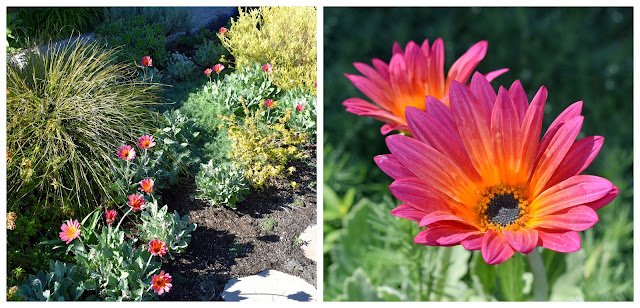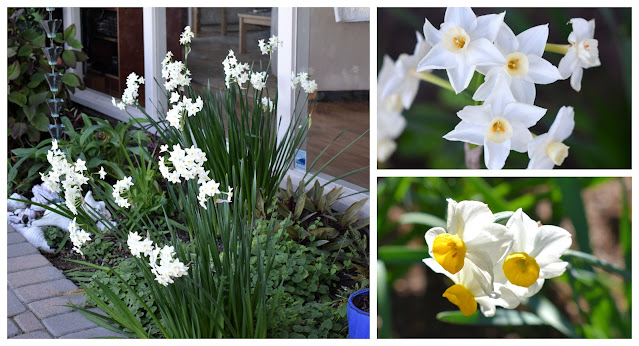It's looking - and feeling - a little more like Spring with every passing day. Much as I appreciate the warm sun on my back as I work in the garden, I'd happily put Spring's advance on hold for awhile if we could get additional winter rain. That said, I'm enjoying the early Spring blooms as they appear.
 |
| This is Anemone coronaria 'Admiral', making its earliest appearance in my garden yet. A few additional blooms of the same cultivar are queued up to follow. |
 |
| After December's heavier-than-usual rain, Arctotis 'Pink Sugar' has responded to January's warmer temperatures with a bounty of blooms |
 |
| The paperwhite Narcissi tazetta usually get a slow start in January but the sheer volume of flowers in both the front and back gardens is greater this year |
A traditionally late winter arrival also showed up a couple of weeks ago and it's rapidly spreading along the property line at the south end of my garden.
If online sources are to be credited, there is more than one genus of wild cucumber but frankly they look identical to me and possess similar characteristics. One of these, Echinocystis lobata, is said to be native to a large part of the US (but not California). The other, Marah macrocarpa, is native to Southern and Baja California. You can read more about California's native the wild cucumber here. For more Wednesday Vignettes, visit Anna at Flutter & Hum.
All material © 2012-2022 by Kris Peterson for Late to the Garden Party




I can only dream of anything like your Narcissus display in my own garden. For some reason, my daffodils performance is dismal. Hundred of bulbs later, I have little to show for.
ReplyDeleteI love the Yucca in the stump. Not only is it deterring the critters, but it looks great. It it growing well?
Even though I made every effort to firmly tamp down the soil in the middle of that stump before planting the Yucca but it's still sunken quite a bit since then. However, as the raccoons haven't entirely broken their habit of "marking" the spot, I've abandoned the prospect of digging in there to raise the soil level. Despite the raccoons' deposits - or perhaps because of them - the Yucca seems to be doing fine. I think it's been there since 2017.
DeleteInteresting how you mark spring in your climate. I get it, and I would love it. But the seasonal changes in S. California are so much more nuanced than they are here. It's really, really dramatic to go from winter to spring here...they are so very different! I think I would like to spend part of winter in your part of the world. I do love it here from May through October, though. Your blooms are stunning! That African Daisy is wowza!
ReplyDeleteWe really just have 2 seasons, Beth: a cool season and a warm season. The cool season generally brings rain, which is its most dramatic aspect but lately all too infrequent. The only questions about the warm season are: how hot is it going to get? and how many fires will we have?
DeleteWhat a coincidence that you too had a shot colored pink by the sun! I do hope you get some more rain before the heat comes. It truly looks spring-y where you are. We're not quite there yet, but the week so far has been high skies and sun - at least after the morning fogs lift.
ReplyDeleteI'll be very sad if we don't get any rain in February and March, Anna. Even sunny skies and flowers can't make up for another terribly dry year.
DeleteHopeful news as we experience more intense winter weather here. Spring will come!
ReplyDeleteI do hope there is more rain for you before meteorological spring arrives.
Fingers crossed!
DeleteYou've brought back a wonderful memory of finding wild cucumber at the Theodore Payne Foundation. They were so spiky!
ReplyDeleteI think I must have cut back the vine before it produced fruit, Loree, as I can't recall seeing it anywhere other than online. It does ramble but I'll see if I can let it do its thing this year.
DeleteI think you're a couple of weeks ahead of us.
ReplyDeleteHow about we keep these temperatures and add the occasional storm? I don't want to go back to winter, but we do need more rain.
I vote for whatever compromise Mother Nature is willing to effect that puts us closer to "normal" rainfall in SoCal, Gerhard. We're well behind NorCal even with December's heavier-than-usual rain. 6.72 inches of rain is better than last year's paltry total of 4.12 inches but it's not nearly enough.
DeleteThe Marah is all over here, though not in my garden, but roadside along with Toyon and Malosma. It's quite ornamental, but the seed pods spines are scary.
ReplyDeleteEnjoying 'Pink Sugar' here too.
It's interesting that you see Marah paired with Toyon. The Marah I featured grew alongside the Toyons that used to occupy that area. I wonder if they're symbiotic plants.
DeleteOh lovely to see that you have signs of spring Kris. The cucumber vine is completely unknown to me. Does it spread much? I imagine that the spiny fruits might deter some unwelcome visitors to your garden.
ReplyDeleteThe Marah vines can grow 20+ feet fairly quickly, Anna, which is why I've generally cut them back early without allowing the fruit to develop. As the local critters are often more savvy than the human residents, they probably recognize the plant as poisonous and steer clear of it.
Delete